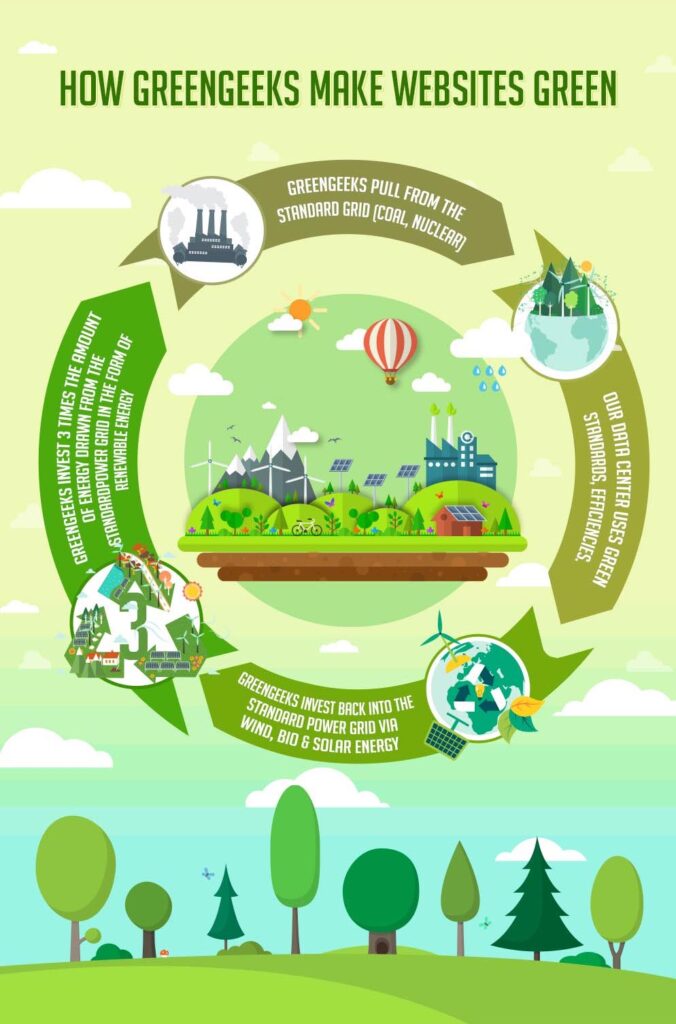A carbon-neutral website? Is that even possible? Yes and No. Technically speaking because we have switched to a greener website host, that uses renewable energy and buys carbon credits to offset its use of fossil fuels by 300% – we could say that our website is carbon neutral. And because we plant trees and donate money to charity, we are already doing what most ‘big’ companies should be doing. However, since our website host Greengeeks still uses fossil fuels to start with, we don’t feel that this is the correct way to tout that we’ve achieved carbon-neutral status. Buying Carbon credits isn’t the answer – reducing our overall energy consumption – and sourcing our energy from clean and green energy sources, is where we’d like to be. But moving away from WP engine was a good step forward for us.
We’d like to see Greengeeks use green, eco-friendly power to start with, rather than offsetting up to 300% (which is very generous) – but we also understand that green power isn’t as readily available as energy pulled from the standard grid. We’d like to see Greengeeks actually investing some of their money into green power alternatives, but even then when we looked at energy providers – it’s still not totally clear how greener tariffs are packaged up.
For now, we are happier to be on Greengeeks whilst we explore greener alternatives and ways to reduce the energy our website uses every day.

We’ve made a switch from WP Engine to Green Geeks which is a start. They aren’t the perfect switch but they are considerably better for us at this time. Our website is pretty big, and it uses a lot of images, code and customisation – which means more power is used to load a page on our website.
We recently discovered that the CO2 associated with page loads is 1.76g (source Website Carbon). You can visit websitecarbon.com and scan your own website and it will tell you how dirty it is. We tried it and ours came back as 0.91g of CO2 with every page load.
We also tested it against some other leading websites that sell fashion and some competitor directories – this is what we found:
- Good on You Website score came back as 0.92g of CO2 – and appears to be running on sustainable energy and was stated as cleaner than 51% of web pages tested
- H&M UK website score came back as 1.55g of CO2 – and appears to be running on sustainable energy
- Zara UK website score came back as 0.98g of CO2 – and appears to be running on sustainable energy
- Shein website score came back as 0.58g of CO2 – and appears to be using bog standard energy (derived from natural resources) If this site used green hosting, then it would emit 9% less CO2
- Low Tech Magazine produces just 0.24g of CO2 per page view
There is such a thing as the Sustainable Web Manifesto, which appeared in 2019. Companies can sign up and pledge their commitment to creating a more sustainable internet. The average website is estimated to be: produce 2,112 kg CO2 every year.

FAST TRACK YOUR BRAND
Get the 12 steps to becoming an awesome ethical brand
6 Week Challenge
We respect your information and comply with GDPR.
How to reduce your websites CO2
- Remove unnecessary images
- Eliminate any code that’s cluttering up your pages
- Reduce the number of videos
- Avoid using carousels
- Stick to basic fonts
- Smart designs that are designed with sustainability in mind, are created to have a light load speed, which is more energy efficient
- A slow load means your pages are using more energy – this is a great place to start – remove decorative features that don’t add value to the pages
That’s all we’ve got to share at this time, but we’ll be sharing more updates on the steps we’re taking to reduce our impact.
Ethical Brand Network Team
